North American F-86 Sabre Video - Greatest Ever: Fighters #6
|
|
|
|
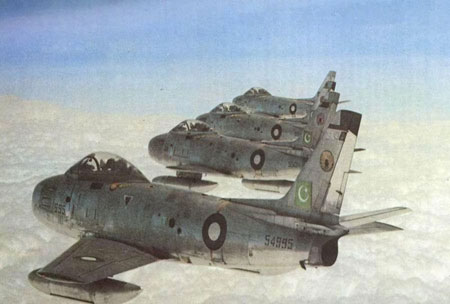 |
Crew: 1 Length: 37 ft 1 in (11.4 m) Wingspan: 37 ft 0 in (11.3 m) Height: 14 ft 1 in (4.5 m) Maximum speed: 687 mph Range: 1,525 mi, (1,753 NM, 2,454 km) |
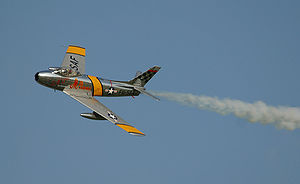 (Image:
A North American F-86 during the Oshkosh Air Show)
(Image:
A North American F-86 during the Oshkosh Air Show)
Role: Fighter aircraft
National origin: United States
Manufacturer: North American Aviation
First flight: 1 October 1947
Introduced: 1949, USAF
Retired: 1994, Bolivia
Primary users: United States Air Force, Japanese Air Self-Defense Force, Spanish Air Force, Republic of Korea Air Force
Number built: 9,860
Unit cost: US$219,457 (F-86E)[1]
Developed: from FJ-1 Fury
Variants: F-86D Sabre, Canadair Sabre, CAC Sabre, FJ-2/3/4 Fury
North American YF-93The North American Aviation F-86 Sabre (sometimes called the Sabrejet) was a transonic jet fighter aircraft. The Sabre is best known for its Korean War role where it was pitted against the Soviet MiG-15 and obtained UN air superiority. Although developed in the late 1940s and outdated by the end of the 1950s, the Sabre proved adaptable and continued as a front line fighter in air forces until the last active front line examples were retired by the Bolivian Air Force in 1994.
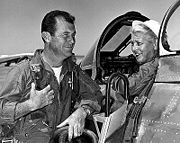 (Image:
Jackie Cochran in the cockpit of the Canadair Sabre with Chuck Yeager)
(Image:
Jackie Cochran in the cockpit of the Canadair Sabre with Chuck Yeager)
Its success led to an extended production run of over 7,800 aircraft between 1949 and 1956, in the United States, Japan and Italy. It was by far the most-produced Western jet fighter, with total production of all variants at 9,860 units.
Variants were built in Canada and Australia. The Canadair Sabre added another 1,815 airframes, and the significantly re-designed CAC Sabre (sometimes known as the Avon Sabre or CAC CA-27), had a production run of 112.
Design and development
Initial proposals to meet a USAAF requirement for a single-seat high-altitude day fighter aircraft/escort fighter/fighter bomber were made in late 1944, and were originally to be derived from the design of the straight wing FJ-1 Fury being developed for the U.S. Navy. The North American P-86 Sabre was the first American aircraft to take advantage of flight research data seized from the German aerodynamicists at the end of the war. Performance requirements were met by incorporating a 35 degree swept-back wing with automatic slats into the design, using the Me 262 wing profile, Messerschmitt wing A layout and adjustable stabilizer. Manufacturing was not begun until after World War II as a result. The XP-86 prototype, which would become the F-86 Sabre, first flew on 1 October 1947 from Muroc Dry Lake, California.
The USAF Strategic Air Command had F-86 Sabres in service from 1949 through 1950. The F-86s were assigned to the 22nd Bomb Wing, the 1st Fighter Wing and the 1st Fighter Interceptor Wing.
The F-86 was produced as both a fighter-interceptor and fighter-bomber. Several variants were introduced over its production life, with improvements and different armament implemented (see below). The XP-86 (eXperimental Pursuit) was fitted with a J35-C-3 jet engine that produced 4,000 lbf (18 kN) of thrust. This engine was built by GM's Chevrolet division until production was turned over to Allison. The J47-GE-7 engine was used in the F-86A-1 producing a thrust of 5,200 lbf (23 kN) while the General Electric J73-GE-3 engine of the F-86H produced 9,250 lbf of thrust. The F-86 was the primary U.S. air combat fighter during the Korean War, with significant numbers of the first three production models seeing combat.
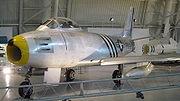 (Image:
Sabre at NASM in livery of 4th Fighter-Interceptor Wing)
(Image:
Sabre at NASM in livery of 4th Fighter-Interceptor Wing)
The fighter-bomber version (F-86H) could carry up to 2,000 pounds (900 kg) of bombs, including an external fuel-type tank that could carry napalm.
Both the interceptor and fighter versions carried six .50-inch (12.7 mm) AN/M3 Browning machine guns with electrically-boosted feed in the nose (later versions of the F-86H carried four 20 mm cannons instead of machine guns). Firing at a rate of 1,200 rounds per minute each, the .50-caliber guns were harmonized to converge at 1,000 ft (300 m) in front of the aircraft, using armor-piercing (AP) and armor-piercing incendiary (API) rounds, with one armor-piercing incendiary tracer (APIT) for every five AP or API rounds. The API rounds used during the Korean War contained magnesium, which were designed to ignite upon impact but burned poorly above 35,000 ft (11,000 m) as oxygen levels were insufficient to sustain combustion at that height. Initially fitted with the Mark 18 manual-ranging computing gun sight, later models used A-1CM radar ranging gunsight which used radar to compute the range of a target. This would later to prove a significant advantage against MiG opponents over Korea, and fitted to later supersonic fighters such as the F-100 and F-105.
Unguided 2.75 inch (70 mm) rockets were used on some of the fighters in target practice, but 5 inch (127 mm) rockets were later used in combat operations. The F-86 could also be fitted with a pair of external jettisonable fuel tanks (four on the F-86F beginning in 1953) that extended the range of the aircraft.
The F-86 Sabre was also license produced by Canadair Limited in Montreal as the Canadair Sabre. The final variant of the Canadian Sabres, the Mk 6, is generally rated as being one of the most capable of all Sabre variants built anywhere. The last Sabre to be manufactured by Canadair Ltd. (Sabre #1815) now resides at the Western Canada Aviation Museum (WCAM)'s permanent collection in Winnipeg, Canada after being donated by the Pakistan Air Force.
Breaking sound barrier and other records
The F-86A set its first official world speed record of 570 mph (920 km/h) in September 1948.
Several people involved with the development of the F-86, including the chief aerodynamicist for the project and one of its other test pilots, claimed that North American test pilot George Welch had broken the sound barrier in a dive with the XP-86 while on a test flight 1 October 1947. (Chuck Yeager went supersonic on 14 October 1947 in the rocket powered Bell X-1, the first aircraft to sustain supersonic speeds in level flight, making it the first "true" supersonic aircraft.)
On 18 May 1953, Jacqueline Cochran flying a Canadian-built F-86E alongside Chuck Yeager, became the first woman to break the sound barrier.
Operational history
Korean War
 (Image:
51st FIG "Checkertails" at K-13 air base (Suwon, South Korea) are prepared for a mission)
(Image:
51st FIG "Checkertails" at K-13 air base (Suwon, South Korea) are prepared for a mission)
The F-86 entered service with the United States Air Force in 1949, joining the 1st Fighter Wing's 94th Fighter Squadron "Hat-in-the-Ring" and became the primary air-to-air jet fighter used in the Korean War. With the introduction of the Soviet Mikoyan-Gurevich MiG-15 into air combat in November 1950, which out-performed all aircraft then assigned to the United Nations, three squadrons of F-86s were rushed to the Far East in December. The F-86 could out-turn and out-dive the MiG-15, but the MiG-15 was superior to the F-86 in ceiling, acceleration, rate of climb, and zoom (especially until the introduction of the F-86F in 1953); MiGs flown from bases in Manchuria by Chinese, Korean, and Soviet VVS pilots, were pitted against two squadrons of the 4th Fighter-Interceptor Wing forward-based at K-14, Kimpo, Korea.
Many of the American pilots were experienced World War II veterans while the North Koreans and the Chinese lacked combat experience, thus accounting for much of the F-86's success. However, whatever the actual results may be, it is clear that the F-86 pilots did not have as much success over the better trained Soviet piloted MiG-15s. Although Soviets piloted the majority of MiG-15s that fought in Korea, North Korean and Chinese pilots increased their activity as the war went on. The Soviets and their allies periodically contested air superiority in MiG Alley, an area near the mouth of the Yalu River (the boundary between Korea and China) over which the most intense air-to-air combat took place. The F-86E's all-moving tailplane has been credited with giving the Sabre an important advantage over the MiG-15. Far greater emphasis has been given to the training, aggressiveness and experience of the F-86 pilots. Despite rules-of-engagement to the contrary, F-86 units frequently initiated combat over MiG bases in the Manchurian "sanctuary."
The needs of combat operation balanced against the need to maintain an adequate force structure in Western Europe led to the conversion of the 51st Fighter-Interceptor Wing from the F-80 to the F-86 in December 1951. Two fighter-bomber wings, the 8th and 18th, converted to the F-86F in the spring of 1953. No. 2 Squadron, South African Air Force also distinguished itself flying F-86s in Korea as part of the 18 FBW.
By the end of hostilities, F-86 pilots were credited with shooting down 792 MiGs for a loss of only 78 Sabres, a victory ratio of 10 to 1. Postwar totals officially credited by the USAF are 379 kills for 103 Sabres lost, amounting to a ratio of nearly 4 to 1. Modern research by Dorr, Lake and Thompson has claimed the actual ratio is closer to 2 to 1.
The Soviet claims of downing over 600 Sabres together with the Chinese claims are considered exaggerated by the USAF. Recent USAF records show that 224 F-86s were lost to all causes, including non-combat losses. But direct comparison of Sabre and MiG losses seem irrelevant, since primary targets for MiGs were heavy B-29 bombers and ground-attack aircraft, while the primary targets for Sabres were MiG-15s.
A recent RAND report made reference to "recent scholarship" of F-86 vs. MiG-15 combat over Korea and concluded that the actual kill:loss ratio for the F-86 was 1.8:1 overall, and likely 1.3:1 against MiGs flown by Soviet pilots; however, the report has been under fire for various misrepresentations.
Of the 40 American pilots who earned the designation of ace during the Korean war, all but one flew the F-86 Sabre. (The other was a Navy F4U Corsair night fighter pilot.)
1958 Taiwan Strait Crisis
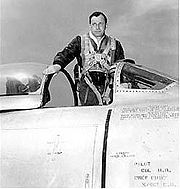 (Image: Col. Harrison
R. Thyng with his F-86 Sabre)
(Image: Col. Harrison
R. Thyng with his F-86 Sabre)
The Republic of China Air Force of Taiwan was one of the first recipients of surplus USAF Sabres. From December 1954 to June 1956, the ROC Air Force received 160 ex-USAF F-86F-1-NA through F-86F-30-NA fighters. By June 1958, the Nationalist Chinese had built up an impressive fighter force, with 320 F-86Fs and seven RF-86Fs having been delivered.
Sabres and MiGs were shortly to battle each other in the skies of Asia once again in the Second Taiwan Strait Crisis. In August 1958, the Chinese Communists of the People's Republic of China attempted to force the Nationalists off of the islands of Quemoy and Matsu by shelling and blockade. Nationalist F-86Fs flying CAP over the islands found themselves confronted by Communist MiG-15s and MiG-17s, and there were numerous dogfights.
During these battles, the Nationalist Sabres introduced a new element into aerial warfare — under a secret effort designated Operation Black Magic, the US Navy had provided the ROC with the AIM-9 Sidewinder, its first infrared-homing air-to-air missile, which was just entering service with the United States. A small team from VMF-323, a Marine FJ-4 Fury squadron with later assistance from China Lake and North American initially modified 20 of the F-86 Sabres to carry a pair of Sidewinders on underwing launch rails and instructed the ROC pilots in their use flying profiles with USAF F-100s simulating the MiG-17. The MiGs enjoyed an altitude advantage over the Sabres as they had in Korea and Communist Chinese MiGs routinely cruised over the Nationalist Sabres, only engaging when they had a favorable position. The Sidewinder took away that advantage and proved to be devastatingly effective against the MiGs.
The combat introduction of the Sidewinder took place in a battle on 24 September 1958 when ROC Sabres succeeded in destroying 10 MiGs and scoring two probables without loss to themselves. In one month of air battles over Quemoy and Matsu, Nationalist pilots tallied a score of no less than 29 MiGs destroyed and eight probables, against a loss of two F-84Gs and no Sabres.
Indo-Pakistani War of 1965
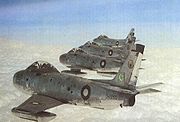 (Image:
PAF F-86 Sabres which took part in the 1965 and 1971 Indo-Pak wars)
(Image:
PAF F-86 Sabres which took part in the 1965 and 1971 Indo-Pak wars)
The F-86 entered service with the Pakistan Air Force (PAF) in 1954 with the first batch of 120 aircraft. Most of the aircraft were of the F-86F-40 configuration except for a few F-86F-35s. The F-86 was operated by nine PAF squadrons at various times. During the Indo-Pakistan war of 1965 the F-86 became the mainstay of the PAF and provided a qualitative edge against a larger Indian Air Force (IAF).
In the air-to-air combat of the Indo-Pakistani War of 1965, the PAF Sabres claimed to have shot down 15 IAF aircraft, comprising of nine Hunters, four Vampires and two Gnats. India however, admitted a loss of 14 combat aircraft to the PAF's F-86s. The F-86s of the PAF had the advantage of being armed with AIM-9B/GAR-8 Sidewinder missiles whereas none of its Indian adversaries had this capability. Despite this, the IAF claimed to have shot down 13 PAF Sabres in air-to-air combat. This claim is disputed by the PAF who admit to having lost 13 F-86s Sabres during the whole 23 days but only seven of them during air-to-air battles.
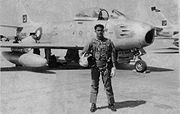 (Image:
Waleed Ehsanul Karim with his ill fated F-86 Sabre Jet in April 1965)
(Image:
Waleed Ehsanul Karim with his ill fated F-86 Sabre Jet in April 1965)
The PAF Sabres performed well in ground attack with claims of destroying around 36 aircraft on the ground at Indian airfields at Halwara, Kalaikunda, Baghdogra, Srinagar and Pathankot.
India only acknowledges 22 aircraft lost on the ground to strikes partly attributed to the PAF's F-86s and its bomber B-57 Canberra.
Pakistani F-86s were also used against advancing columns of the Indian army when No. 19 Squadron Sabres engaged the Indian Army using five inch (127 mm) rockets along with their six Browning M3 .50 in (12.7 mm) caliber machine guns. According to Pakistan reports, Indian armor bore the brunt of this particular attack at Wagah. The Number 14 PAF Squadron earned the nickname "Tailchoppers" in PAF for their F-86 operations and actions during the 1965 war.
During the war, United States barred the sales of the F-86 to Pakistan. Nonetheless, Pakistan maintained its F-86 fleet through sales of around 90 Iranian Sabres and Sabre Mk 6 CL-13s (Canadian-made F-86 Sabres) which formed the backbone of the operations during the Bangladesh Liberation War, 1971. Despite its formidable performance, the F-86 proved vulnerable to the diminutive Folland Gnat, which proved to be fast, nimble and hard to see. The IAF Gnats, given the nickname "Sabre Slayer," claimed to have downed seven PAF Sabres.
Pakistan Air Force F-86 Flying Ace Sqn Ldr Muhammad Mahmood Alam, officially credited with five kills in air-to-air combat, three of them in less than a minute.
Bangladesh Liberation War 1971
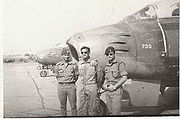 (Image:
Although 11 Sabres in East Pakistan were disabled by the PAF themselves during the Bangladesh Liberation War to prevent them from being used by the enemy,
a few were recovered intact and were flown later by the Bangladesh Air Force. The photo above shows Indian officers standing next to these PAF Sabre
jets at Dhaka airport.)
(Image:
Although 11 Sabres in East Pakistan were disabled by the PAF themselves during the Bangladesh Liberation War to prevent them from being used by the enemy,
a few were recovered intact and were flown later by the Bangladesh Air Force. The photo above shows Indian officers standing next to these PAF Sabre
jets at Dhaka airport.)
The Canadair Sabres (Mark 6) acquired from ex-Luftwaffe stocks via Iran, were the mainstay of the PAF's day fighter operations during the Bangladesh Liberation War 1971, and had the challenge of dealing with the threat from IAF. Despite having acquired newer fighter types such as the Mirage III and the Shenyang F-6, the Sabre Mark 6 (widely regarded as the best "dog-fighter" of its era) along with the older PAF F-86Fs, were tasked with the majority of operations during the war, due to the small numbers of the Mirages and combat unreadiness of the Shenyang F-6. In East Pakistan only one PAF F-86 squadron (14th Squadron) was deployed to face the formidable IAF Soviet MiG-21s and the Sukhoi SU-7 and the numerical superiority of the IAF. At the beginning of the war, PAF had eight squadrons of F-86 Sabres.
Despite these challenges, the PAF F-86s performed well with Pakistani claims of downing 31 Indian aircraft in air-to-air combat including 17 Hawker Hunters, eight Sukhoi SU 7 "Fitters", one MiG 21s and three Gnats while losing seven F-86s. India however claims to have shot down 11 PAF Sabres for the loss of 11 combat aircraft to the PAF F-86s. The IAF numerical superiority overwhelmed the sole East Pakistan Sabres squadron (and other military aircraft) which were either shot down, or grounded by Pakistani Fratricide as they could not hold out, enabling complete Air superiority for the Indian Air Force.
In the Battle of Boyra, the first notable air engagement over East Pakistan, India claimed four Gnats downed three Sabres while Pakistan acknowledges only two Sabres were lost while one Gnat was shot down. As per official Pakistan accounts, 24 Sabres were lost in the war: 13 due to enemy action and 11 disabled by PAF forces to keep them out of enemy hands, while 28 Sabres were lost per Indian accounts: 17 due to IAF action and 11 disabled by the PAF on the ground to keep them out of enemy hands. Five of these Sabres, however, were recovered in working condition and flown again by the Bangladesh Air Force.
After this war, Pakistan slowly phased out its F-86 Sabres and replaced them with Chinese F-6 (Russian MiG-19 based) fighters. The last of the Sabres were withdrawn from service in PAF in 1980. F-86 Sabres nevertheless remain a legend in Pakistan and are seen as a symbol of pride. They are now displayed in Pakistan Air Force Museum and in the cities to which their pilots lived.
Guinea Bissau
Based at AB2-Bissau/Bissalanca in 1961-1964, some F-86Fs were deployed in Guinea in 1961 where they were used in ground attack and close support operations. These aircraft formed “Detachment 52”, equipped with eight F-86Fs (serials: 5307, 5314, 5322, 5326, 5354, 5356, 5361 and 5362) of the Esquadra 51, based at the Base Aerea 5, in Monte Real, Portugal. In August 1962, 5314 overshot the runway during emergency landing with bombs still attached on underwing hardpoints and burned out. F-86 5322 was shot down by enemy ground fire on 31 May 1963; the pilot ejected safely and was recovered. Several other aircraft suffered combat damage, but were repaired.
In 1964, 16 F-86Fs based at Bissalanca returned to mainland due to U.S. pressure. They had flew 577 combat sorties, of which 430 were ground attack and close air support missions. During these operations, one FAP Sabre was shot down and other crashed.
Variants
North American F-86
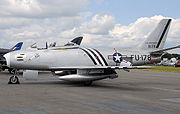 XF-86
XF-86
three prototypes, originally designated XP-86, North American model NA-140
(Image: Preserved airworthy F-86A Sabre at Kemble Air Day 2008, England.)
YF-86A
this was the first prototype fitted with a General Electric J47 turbojet engine.
F-86A
554 built, North American model NA-151 (F-86A-1 block and first order of A-5 block) and NA-161 (second F-86A-5 block)
DF-86A
A few F-86A conversions as drone directors
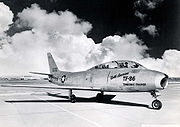 RF-86A
RF-86A
11 F-86A conversions with three cameras for reconnaissance
(Image: TF-86F)
F-86B
188 ordered as upgraded A-model with wider fuselage and larger tires but delivered as F-86A-5, North American model NA-152
F-86C
original designation for the YF-93A, two built (S/N 48-317 & 48-318), order for 118 cancelled, North American model NA-157
YF-86D
prototype all-weather interceptor originally ordered as YF-95A, two built but designation changed to YF-86D, North American model NA-164
F-86D
Production interceptor originally designated F-95A, 2,506 built. See F-86D Sabre.
F-86E
Improved flight control system and an "all-flying tail" (This system changed to a full power-operated control with an "artificial feel" built into the aircraft's controls to give the pilot forces on the stick that were still conventional, but light enough for superior combat control. It improved high speed maneuverability); 456 built, North American model NA-170 (F-86E-1 and E-5 blocks), NA-172, essentially the F-86F airframe with the F-86E engine (F-86E-10 and E-15 blocks); 60 of these built by Canadair for USAF (F-86E-6)
F-86E(M)
Designation for ex-RAF Sabres diverted to other NATO air forces
QF-86E
Designation for surplus RCAF Sabre Mk. Vs modified to target drones
(Image: F-86H s/n 53-1308, Restorations, Wings Museum, Denver, CO.)
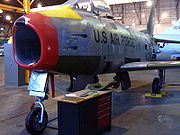 F-86F
F-86F
Uprated engine and larger "6-3" wing without leading edge slats, 2,239 built; North American model NA-172 (F-86F-1 through F-15 blocks), NA-176 (F-86F-20 and -25 blocks), NA-191 (F-86F-30 and -35 blocks), NA-193 (F-86F-26 block), NA-202 (F-86F-35 block), NA-227 (first two orders of F-86F-40 blocks comprising 280 aircraft which reverted to leading edge wing slats of an improved design), NA-231 (70 in third F-40 block order), NA-238 (110 in fourth F-40 block order), and NA-256 (120 in final F-40 block order); 300 additional airframes in this series assembled by Mitsubishi in Japan for Japanese Air Self-Defense Force. Sabre Fs had much improved high speed agility, coupled with a higher landing speed of over 145 mph (233 km/h). The F-35 block had provisions for a new task: the nuclear tactical attack with one of the new small "nukes" ("second generation" nuclear ordnance). The F-40 had a new slatted wing, with a slight decrease of speed, but also a much better agility at high and low speed with a landing speed reduced to 124 mph (200 km/h). The USAF upgraded many of previous F versions to the F-40 standard.
QF-86F
About 50 former JASDF F-86F airframes converted to drones for use as targets by the U.S. Navy
RF-86F
Some F-86F-30s converted with three cameras for reconnaissance; also eighteen JASDF aircraft similarly converted
TF-86F
Two F-86F converted to two-seat training configuration with lengthened fuselage and slatted wings under North American model NA-204
YF-86H
Extensively redesigned fighter-bomber model with deeper fuselage, uprated engine, longer wings and power-boosted tailplane, two built as
North American model NA-187
F-86H
Production model, 473 built, with Low Altitude Bombing System (LABS) and provision for nuclear weapon, North American model NA-187 (F-86H-1
and H-5 blocks) and NA-203 (F-86H-10 block)
QF-86H
Target conversion of 29 airframes for use at United States Naval Weapons Center
F-86J
Single F-86A-5-NA, serial 49-1069, flown with Orenda turbojet under North American model NA-167 - same designation reserved for A-models
flown with the Canadian engines but project not proceeded with
CAC Sabre (Australia)
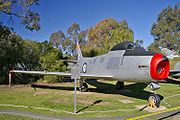 (Image:
CAC Sabre Mk 32 at the Wagga Wagga RAAF Museum)
(Image:
CAC Sabre Mk 32 at the Wagga Wagga RAAF Museum)
Two types based on the US F-86F were built under licence by the Commonwealth Aircraft Corporation (CAC) in Australia, for the Royal Australian Air Force. as the CA-26 (one prototype) and CA-27 (production variant).
The CAC Sabres included a 60% fuselage redesign, to accommodate the Rolls-Royce Avon Mk 26 engine, which had roughly 50% more thrust than the J47, as well as 30 mm Aden cannons and AIM-9 Sidewinder missiles. As a consequence of its powerplant, the Australian-built Sabres are commonly referred to as the Avon Sabre. CAC manufactured 112 of these aircraft.
CA-27 marques:
Mk 30: 21 built, wing slats, Avon 20 engine
Mk 31: 21 built, 6-3 wing, Avon 20 engine
Mk 32: 69 built, four wing pylons, F-86F fuel capacity, Avon 26 engine
The RAAF operated the CA-27 from 1956 to 1971. Ex-RAAF Avon Sabres were operated by the Royal Malaysian Air Force (TUDM) between 1969 and 1972. From 1973 to 1975, 23 Avon Sabres were donated to the Indonesian Air Force (TNI-AU); five of these were ex-Malaysian aircraft.
Canadair Sabre
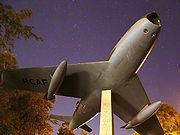 (Image:
F-86 Sabre monument at the Royal Military College of Canada in Kingston, Ontario.)
(Image:
F-86 Sabre monument at the Royal Military College of Canada in Kingston, Ontario.)
The F-86 was also manufactured by Canadair in Canada as the CL-13 Sabre to replace its de Havilland Vampires, with the following production models:
Sabre Mk 1
one built, prototype F-86A
Sabre Mk 2
350 built, F-86E-type, 60 to USAF, three to RAF, 287 to RCAF
Sabre Mk 3
one built in Canada, test-bed for the Orenda jet engine
Sabre Mk 4
438 built, production Mk 3, 10 to RCAF, 428 to RAF as Sabre F 4
Sabre Mk 5
370 built, F-86F-type with Orenda engine, 295 to RCAF, 75 to Luftwaffe
Sabre Mk 6
655 built, 390 to RCAF, 225 to Luftwaffe, six to Colombia and 34 to South Africa
Related development
FJ-1 Fury
F-86D Sabre
Canadair Sabre
CAC Sabre
FJ-2/3/4 Fury
North American YF-93
Fuji T-1
F-100 Super Sabre
Comparable aircraft
F-9 Cougar
FMA IAe 33 Pulqui II
F-84F Thunderstreak
Dassault Mystère
Focke-Wulf Ta-183
Hawker Hunter
Lavochkin La-15
Mikoyan-Gurevich MiG-15
Mikoyan-Gurevich MiG-17
Saab 29 Tunnan
Production summary
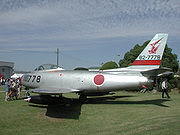 NAA built a total of 6,297 F-86s and 1,115 FJs,
NAA built a total of 6,297 F-86s and 1,115 FJs,
Canadair built 1,815,
Australian CAC built 112,
Fiat built 221, and
Mitsubishi built 300;
for a total Sabre/Fury production of 9,860.
Specifications (F-86F-40-NA)
General characteristics
Crew: 1
Length: 37 ft 1 in (11.4 m)
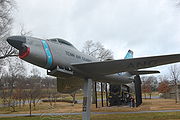 Wingspan: 37 ft 0 in (11.3 m)
Wingspan: 37 ft 0 in (11.3 m)
Height: 14 ft 1 in (4.5 m)
Wing area: 313.4 sq ft (29.11 m²)
Empty weight: 11,125 lb (5,046 kg)
Loaded weight: 15,198 lb (6,894 kg)
Max takeoff weight: 18,152 lb (8,234 kg)
Powerplant: 1x General Electric J47-GE-27 turbojet, 5,910 lbf (maximum thrust at 7.950 rpm for five min) (26.3 kN)
Fuel provisions Internal fuel load: 437 gallons (1,650 l), Drop tanks: 2 x 200 gallons (756 l) JP-4 fuel
Basic mission wing loading: 58 lb/sq ft
Zero-lift drag coefficient: 0.0132
 Drag area: 3.8 sq ft (0.35 m²)
Drag area: 3.8 sq ft (0.35 m²)
Aspect ratio: 4.78
Performance
Maximum speed: 687 mph at sea level at 14,212 lb (6,447 kg) combat weight
also reported 678 mph (1,091 km/h) and 599 at 35,000 feet (11,000 m) at 15,352 pounds (6,960 kg). (597 knots, 1,105 km/h at 6446 m, 1,091 and 964 km/h at 6,960 m.)
Range: 1,525 mi, (1,753 NM, 2,454 km)
Service ceiling 49,600 ft at combat weight (15,100 m)
Rate of climb: 8,100 ft/min at sea level (41 m/s)
Thrust/weight: 0.38
Stalling speed (power off): 124 mph (108 kt, 200 km/h)
Landing ground roll: 2,330 ft, (710 m)
Lift-to-drag ratio: 15.1
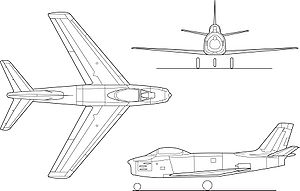 Time to altitude: 5.2 min (clean) to 30,000 ft (9,100 m)
Time to altitude: 5.2 min (clean) to 30,000 ft (9,100 m)
Armament
Guns: 6x 0.50 in (12.7 mm) M2 Browning machine guns (1,602 rounds in total)
Rockets: variety of rocket launchers; e.g: 2x Matra rocket pods with 18x SNEB 68 mm rockets each
Missiles: 2x AIM-9 Sidewinders
Bombs: 5,300 lb (2,400 kg) of payload on four external hardpoints, bombs are usually mounted on outer two pylons as the inner pairs are wet-plumbed pylons for 2x 200 gallons drop tanks to give the Sabre a useful range. A wide variety of bombs can be carried (max standard loadout being 2 x 1,000 lb bombs plus 2 drop tanks), napalm bomb canisters and can include a tactical nuclear weapon.
Source: WikiPedia